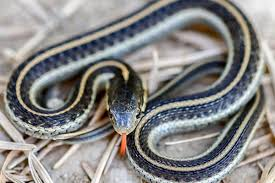Garter Snake

Scientific Name
Thamnophis
Popular Varieties
Garter snakes make great first snakes for families with elementary school-age children and older, because these snakes are active during the day, do not constrict, and do not get very big. Starting at 6-8 inches long, adult snakes do not grow longer than 2-3 feet (males are typically shorter than females) with a girth of only a few inches. Thus, these relatively small snakes are perfect for children to hold as long as they are supervised by adults and don’t squeeze the animals too tightly. When fed and cared for properly and handled often, these snakes are docile and friendly and can live up to 10 years in captivity.
Diet
Wild garter snakes eat a varied diet containing worms, amphibians, fish, eggs, snails, and rodents. While captive garter snakes can be fed predominantly frozen thawed rodents, occasionally they can be offered other prey items such as earthworms, fresh whole feeder fish, frogs, or toads. Adult snakes can be fed once every 7-10 days. Immature, growing, or pregnant snakes should be fed every 4-5 days. Live prey should never be offered, as they can bite and injure the snake.
Health
If garter snakes are fed and housed properly, they are fairly hardy and not likely to develop medical issues. Many snakes carry gastrointestinal parasites that can be identified in microscopic analysis of fresh stool samples and treated with medications accordingly. Many of these parasites, along with Salmonella bacteria commonly present in snakes’ GI tracts, are transmittable to humans; thus, anyone handling snakes or anything in their enclosures should wash their hands thoroughly.
Snakes that are fed excessive amounts of frozen, defrosted fish or immature rodent prey (such as fuzzy and pinky mice) can develop nutritional imbalances. Those that are housed in very small cages and never allowed to come out to exercise can become overweight. Snakes kept too cool are prone to developing infections from improper immune system function and poor digestion. Those that are kept in tanks with poor ventilation and excess moisture commonly develop skin and respiratory infections that typically require veterinary attention.
On the other hand, garter snakes kept under excessively hot, dry conditions without adequate water for soaking may become dehydrated and develop shedding problems such as retained pieces of shed skin. They may also retain their “eye caps,” or corneas, which are normally shed. Snakes with any of these signs should be examined by a veterinarian as soon as possible to determine if treatment is needed. Having your snake checked when you first acquire it, to confirm you are caring for it properly, and annually after that, even if it seems perfectly healthy, can prevent many potentially life-threatening problems and help ensure your Garter lives a long life.
Behavior
Adult snakes can be housed in 30- to 50-gallon (depending on their size) aquariums or plastic tubs with tight-fitting lids, as they are known for their skills as escape artists. They should have a shallow bowl of water large enough in which to soak to stay hydrated, an under-tank heat mat or over-tank heat bulb, a wooden or plastic hide box, and some large rocks on which to rub to help promote shedding of skin. Paper-based bedding (shredded newspaper, butcher paper, paper towels, or commercially available recycled paper products) are ideal, as they allow snakes to bury and hide but are digestible if eaten and do not lead to gastrointestinal (GI) tract obstruction, as sand, soil, and other particulate matter can. Cages should be spot-cleaned of soiled bedding daily, and completely cleaned out weekly. Fresh water should be provided daily.
Tanks should have a temperature gradient, with the warm end maintained in the high 80s °F and the cool end not lower than the mid 70s °F. One thermometer at each end, or a “point and shoot” thermometer gun, should be used to monitor tank temperatures. Either ceramic heat bulbs or mercury-vapor bulbs (providing both heat and ultraviolet [UV] light) may be used as heat sources. While the provision of ultraviolet light to pet snakes is controversial (as UV light is necessary to make vitamin D, which enables calcium absorption from food, and snakes eat whole prey, including the prey’s calcium-rich bones), studies have shown that captive snakes are healthier when provided with UV light. Thus, the warm end of the tank should have basking spot in the 90s °F with a UV bulb mimicking the sun. Lights should be kept on for 10-12 hours per day and turned off at night. Depending on seasonal environmental temperatures, supplemental heat may be needed to maintain appropriate tank temperatures during both day and night.
Environment
While garter snakes are abundant in the wild, especially around bodies of water, such as lakes and streams, in Canada, the U.S., Mexico, and Central America, these wild animals should not be kept as pets, as they are illegal to take from their natural habitats in most locales. Wild garter snakes also tend to be more aggressive and have more medical problems than captive-bred snakes.
There are approximately 75 recognized breeds of garter snakes varying in pattern (with spots, stripes, and speckles) and color, from red to brown to orange, yellow, black, green, and blue. They can be obtained from rescue organizations, pet stores, and breeders. Regardless of where they are acquired, all new pet snakes should have a thorough examination by a snake-savvy veterinarian to ensure they are healthy.